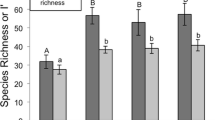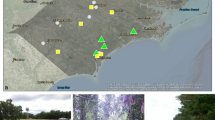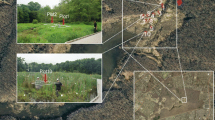Abstract
Vegetation composition, soil morphology, and hydrology were characterized along wetland-to-upland gradients at six forested sites in north-central Florida to compare results of Federal wetland delineation methods with 3–5 yr of hydrologic data. Wetland and non-wetland identifications were supported by hydrology data in eight of nine plant communities. Lack of hydric soil indicators and hydrophytic vegetation in two upland communities (scrub and mixed mesic hardwoods) agreed with a deep water table. Six wetland communities (cypress dome, cypress strand, bayhead, cypress/bayhead, red maple/oak swamp, and cedar swamp) with field indicators of wetland hydrology, hydrophytic vegetation, and hydric soils were inundated or had water tables at or near the ground surface at least 5% of the growing season in most years., Flatwoods communities, however, occurred at intermediate positions on the moisture gradient and could not be consistently identified as wetland or upland communities. Identification of flatwoods as wetlands depended on wetland delineation method and was not usually supported by hydrologic measurements. In the flatwoods community, soil properties and vegetation composition were correlated with the mean and standard deviation of water-table depths, as well as the depth continuously exceeded by the water table at least 5% of the growing season in most years. Various hydrologic parameters need to be considered in addition to the 5% exceedence level currently used in Federal wetland delineation guidance when characterizing wetland conditions in low-gradient areas such as flatwoods.
Similar content being viewed by others
Literature Cited
Abrahamson, W.G. and D.C. Hartnett. 1990. Pine Flatwoods and Dry Prairies. p. 103–149.In R.L. Myers and J.J. Ewel (eds.) Ecosystems of Florida. University of Florida Press, Orlando, FL, USA.
Allen, S.D., F.C. Golet, A.E. Davis, and T.E. Sokolloski. 1989. Soilvegetation correlations in transition zones of Rhode Island red maple swamps, U.S. Fish and Wildlife Service, Office of Biological Services, Washington, DC, USA, FWS/OBS-89/8.
Carter, V., P.T. Gammon, and M.K. Garrett. 1994. Ecotone dynamics and boundary determination in the Great Dismal Swamp. Ecological Applications 4:189–203.
Clark, J.R. and J. Benforado (eds.) 1981. Wetlands of Bottomland Hardwood Forests. Elservier, Amsterdam, The Netherlans.
Davis, M.M., M.T. Brown, and G.R. Best. 1991. Vegetation and Structural Characteristics of Native Ecological Communities. p. 4–1 to 4–58.In M.T Brown and R.E. Tighe (eds.) Techniques and guidelines for reclamation of phosphate mined lands. Center for Wetlands, University of Florida, Gainesville, FL, USA. Final report to Florida Institute of Phosphate Research, Project No. 83-03-044.
Environmental Laboratory. 1987. Corps of Engineers Wetlands Delineation Manual. U. S. Army Engineer Waterways Experiment Station, Vicksburg, MS, USA. Technical Report Y-87-1.
Erickson, N.E. and D.M. Leslie, Jr. 1988. Soil-vegetation correlations in coastal Mississippi wetlands, U. S. Fish and Wildlife Service. Office of Biological Services. Washington, DC, USA. FWS/OBS-89/3.
Federal Interagency Committee for Wetland Delineation. 1989. Federal Manual for Identifying and Delineating Jurisdictional Wetland. U.S Army Corps of Engineers, U.S. Environmental Protection Agency, U.S. Fish and Wildlife Service, and U.S.D.A. Soil Conservation Service, Washington, DC, USA. Cooperative Technical Publication.
Heimburg, K. 1984. Hydrology of North-Central Florida Cypress Domes. p. 72–82.In K.C. Ewel and H.T. Odum (eds.) Cypress Swamps. University of Florida Press. Gamesville, FL, USA.
Hurt, G.W. and R.B. Brown. 1995. Development and application of hydric soil indicators in Florida. Wetlands 15:74–81.
Mitsch, W.J. and J.G. Gosselink. 1993. Wetland, Van Nostrand Reinhold, New York, NY, USA.
Myers, R.L. 1990. Serub and High Pine. p. 150–193.In R.L. Myers and J.J. Ewel (eds.) Ecosystems of Florida. University of Florida Press, Orlando, FI, USA.
Palmer, M.W. 1993. Putting things in even better order: the advantages of canonical correspondence analysis. Ecology 74:2215–2230.
Platt, W.J. and M.W. Swartz. 1990. Temperate Hardwood Forests. p. 194–229.In R.L. Myers and J.J. Ewel (eds.) Ecosystems of Florida. University of Florida Press, Orlando, FL, USA.
Reed, P.B., Jr. 1988. National list of plant species that occur in wetlands: 1988 national summary. U. S. Fish and Wildlife Service, Washington, DC, USA. Biological Report 88(24).
Segal, D.S., S.W. Sprecher, and E.C. Watts. 1995. Relationships between hydric soil indicators and wetland hydrology for sandy soils in Florida. U. S. Army Engineer Water ways Experiment Station, Vickburg, MS, USA. Technical Report WRP-DE-7.
Soil Conservation Service. 1991. Examination and description of soils in the field. U.S. Department of Agriculture, Washington DC, USA. Document 430-V-SSM.
Soil Conservation Service, 1992. Hydric soils of Florida: Soil and water relationships of Florida’s ecological communities. U.S. Department of Agriculture, Gainesville, FL, USA.
Soil Conservation Service. 1994. National Food Security Act Manual, 3rd Edition. U.S. Department of Agriculture, Washington, DC, USA.
Ter Braak, C.J.F. 1986. Canonical correspondence analysis: A new eigenvector technique for multivariate direct gradient analysis. Ecology 67:1167–1179.
Ter Braak, C.J.F. and I.C. Prentice. 1988. A theory of gradient analysis. Advance in Ecological Research 18:271–317.
Wharton, C.H., H.T. Odum, K. Ewel, M. Deuver, A. Lugo, R. Boyt, J. Bartholomew, E. DeBellevue, S. Brown, M. Brown, and L. Deuver. 1977. Forested Wetlands of Florida: Their Management and Use. Division of State Planning, Tallabassee, FL, USA.
Wharton, C.H., W.M. Kitchens, E.C. Pendleton, and T.W. Sipe. 1982. The ecology of bottomland hardwood swamps of the Southeast: a community profile U.S. Fish and Wildlife Service, Office of Biological Services. Washington, DC, USA FWS/OBS-81/37.
Withow, T.H. and R.W. Harris, 1979. Flood tolerance in plants: a state-of-the-art review. U.S. Army Engineer Waterways Experiment Station, Vicksburg, MS, USA. Technical Report E-79-2.
Author information
Authors and Affiliations
Rights and permissions
About this article
Cite this article
Davis, M.M., Sprecher, S.W., Wakeley, J.S. et al. Environmental gradients and identification of wetlands in north-central Florida. Wetlands 16, 512–523 (1996). https://doi.org/10.1007/BF03161341
Received:
Revised:
Accepted:
Issue Date:
DOI: https://doi.org/10.1007/BF03161341




